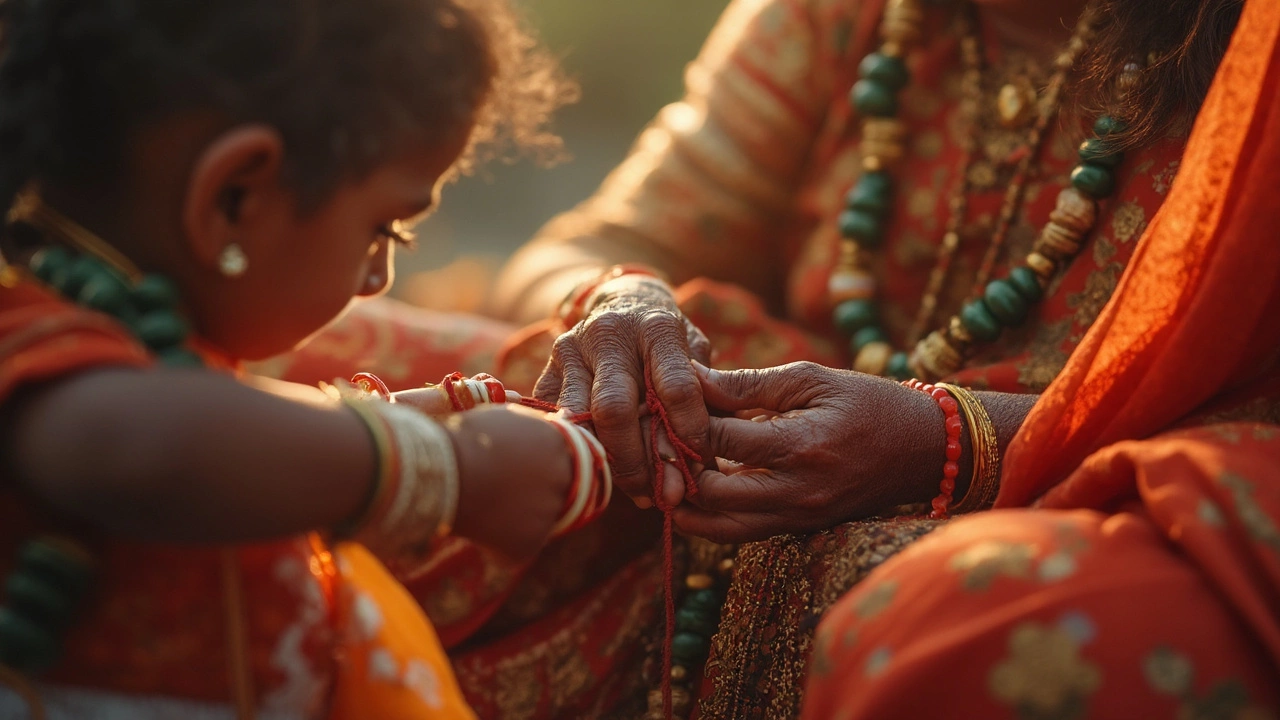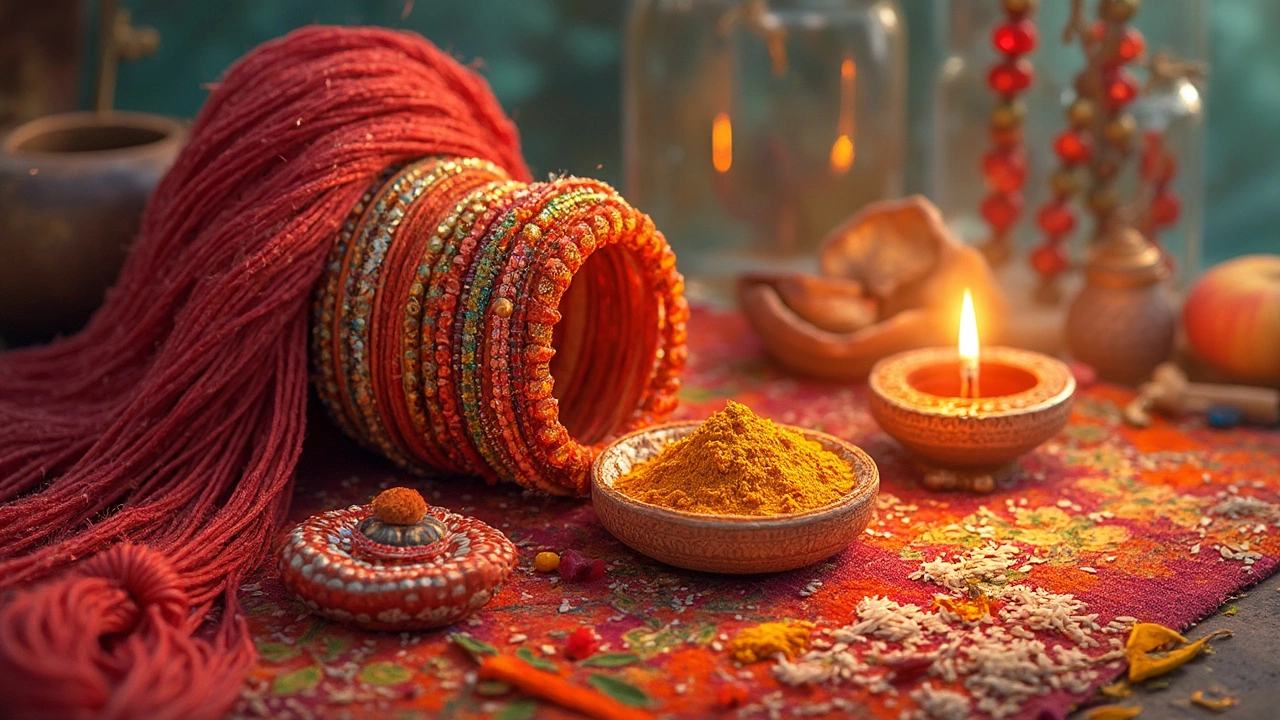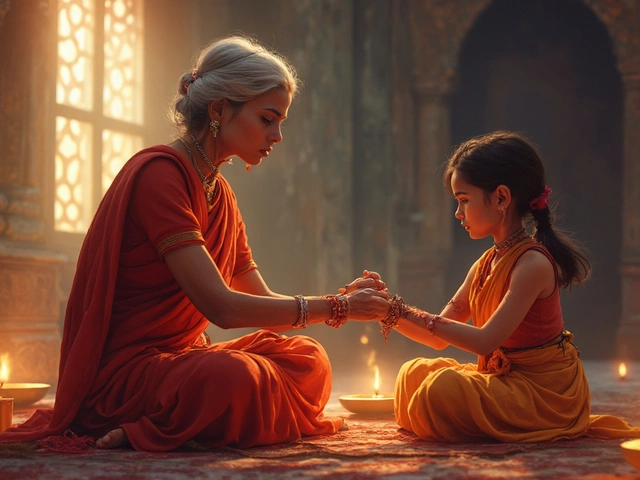If you’ve ever noticed someone’s wrist peeking out from a shirt, with a bright red string tied around it, you’re not alone. In India, you’ll spot it on kids outside school, on office workers holding chai, and on grandmothers lining up at temples. The red string isn’t just a decoration—it’s a symbol loaded with stories, promises, and prayers.
Ask a dozen people why they tie it, and you’ll get nearly as many answers. Some say it keeps away trouble; others say it’s for good luck. Kids like my daughter Sakshi even want to know if it’s just for style. But there’s a lot more under that little knot than most people realize—family traditions, old-school rituals, and some quirky, very specific rules about who wears it when.
- Roots of the Red String Tradition
- The Rituals and When It’s Worn
- Religious Significance and Beliefs
- Red String vs. Traditional Bangles
- Tips on Respectful Wearing Today
Roots of the Red String Tradition
The red string, or “kalava,” has roots going back thousands of years in India. It’s not random—there’s a reason why it’s always red and why it’s usually tied on the wrist. Ancient texts like the Puranas mention this thread, calling it a protector against mishap and a symbol of promises made in front of gods and family.
Typically, the red string is tied during religious ceremonies. For Hindus, it starts with a puja at home or in a temple, where a priest recites Sanskrit mantras. For men, the thread goes on the right wrist; for women, it’s the left. This small ritual is all about marking a fresh start—think exams, weddings, housewarming, even the launch of a new shop.
Here’s why red is the color of choice. In India, red means energy, strength, and purity. It’s not a coincidence that brides wear red or that temple doors are adorned with red cloth. In fact, the red string’s use spread to other countries and religions; for example, some Buddhists in Nepal and Tibet tie a similar thread after prayers, but the roots remain red string traditions from India.
| Tradition | Who Wears It | Occasion |
|---|---|---|
| Hindu Kalava | Mostly Hindus (men: right wrist, women: left wrist) | Puja, festivals, new beginnings |
| Buddhist Prayers | Followers in Nepal, Tibet | Completion of prayers or blessings |
Some families even keep leftover threads from past ceremonies in their prayer rooms, believing these act as extra protection. Older generations remember stories from their own childhoods—like grandmothers tying it before exams or farmers before the first sowing season—each one passing on the tradition, thread by thread.
The Rituals and When It’s Worn
You’ll rarely see the red string tied casually, just for fun. There’s a proper ritual, and it’s honestly pretty simple once you know what’s going on. Most of the time, a priest—or someone respected in the family—ties it during a puja (a Hindu prayer ceremony). They’ll chant a quick prayer, dip the string in holy water or even turmeric paste, and then knot it around the wrist. It isn’t just about protection: it marks the person as blessed, ready to tackle what’s coming next.
The day matters too. In northern and western India, the tradition peaks during festivals like Raksha Bandhan (when sisters tie a thread on brothers), or during temple visits on Tuesdays and Saturdays. Males often get it tied on their right wrist; females, on the left. Apparently, it’s a Vedic thing—something about energy flow and protection.
Here’s a quick table on some common moments when you’ll spot the red string ritual happening:
| Occasion | Reason for Red String |
|---|---|
| Pooja at Home | Blessings, starting new ventures, good luck |
| Raksha Bandhan | Symbol of sibling bond, promise of protection |
| Temple Visits | Mark of devotion, request for divine protection |
| Weddings/Religious Functions | Ensures prosperity, removes negative energy |
If you’re thinking it comes off by sunset—it doesn’t. Most families keep the string on until it frays or falls off by itself. Some people snip it off after a certain number of days (often 7 or 11), but only after saying a short prayer and thanking the universe for helping out.
One small pro tip: If you get the string during a ceremony, don’t cut it with scissors unless you ask someone knowledgeable—grandparents are the go-to experts for this!

Religious Significance and Beliefs
When it comes to the red string, or "kalava" as some call it, religion drives almost every part of the tradition. If you walk into a Hindu temple during any festival or ceremony, you’ll see priests tying the red string on people’s wrists, mumbling prayers for happiness, protection, and sometimes, just to keep bad luck out of your life.
Why red, though? In Hinduism, red stands for strength, purity, and good vibes. It’s also tied to deities like Lakshmi (the goddess of wealth) and Durga (the fierce protector). The red thread acts like a reminder — a kind of wearable promise to stay true to your values and faith. Folks believe it not only protects your body, but also your mind and intentions.
Here’s where it gets even more interesting: men usually wear the red thread on their right wrist, while women and kids wear it on the left. It’s a small detail, but it matters in rituals. There’s also a specific knotting style — priests tie it with three, five, or seven knots, each representing different blessings (like health, wealth, or spiritual growth).
- After a "puja" (prayer ceremony), the string marks your participation — sort of like a souvenir but packed with faith.
- During “Raksha Bandhan,” a similar string is tied to celebrate sibling bonds, but red is still the dominant color.
- Some Jain and Buddhist ceremonies have a similar thread ritual, though reasons and colors can vary.
One survey by the Pew Research Center found that 86% of Hindus in India take part in rituals involving sacred threads at least once a year. That’s not just temple regulars — it’s everyone from school kids to busy professionals who might not even know all the rules behind it.
| Community | Wrist Worn On | Thread Name | Main Belief |
|---|---|---|---|
| Hindus | Right (men), Left (women) | Kalava/Mauli | Blessings, protection |
| Jains | Left | Red-White String | Penance, vows |
| Buddhists | Left or Right | Pirit Thread | Protection, mindfulness |
Even in regular life, some people tie a fresh thread before key moments—like exams, job interviews, or long trips. It’s comfort, hope, and a little bit of tradition all rolled onto your wrist. If you’re ever handed that red string, know you’re carrying a tiny piece of centuries-old belief close to your skin.
Red String vs. Traditional Bangles
People often mix up the meaning behind the red string and bangles, but honestly, they’re almost like apples and oranges. The red string—also known as "kalava" or "mauli"—is all about beliefs, prayers, and protection, while bangles are tied up with tradition, personal style, and sometimes even marital status.
Take a quick peek at prayer days or family functions: the red string goes on after a short ritual—sometimes in a temple, sometimes at home. The person tying it, often a priest or an elder, chants mantras, making this a pretty sacred moment. You’ll hardly catch anyone randomly putting one on for fun. On the other hand, bangles are chosen in the morning like picking a shirt before work. Anyone can wear them, kids to adults, and people swap them out for every mood, color, or occasion.
In most Hindu communities, married women wear glass bangles as a sign of their marital status, especially after the wedding ceremony. The red string isn’t about being married or single. It’s more a sign you’ve prayed or want some divine backup (which most people won’t admit, but it’s true!).
If you like the numbers, here’s a quick comparison:
| Feature | Red String | Bangles |
|---|---|---|
| Material | Cotton thread, dyed red | Glass, metal, gold, plastic |
| Occasion | Religious rituals, temple visits, festivals | Daily wear, weddings, festivals, special events |
| Who Wears It? | Any gender, any age | Mainly women, but also kids, sometimes men |
| Significance | Protection, blessings, spiritual connection | Adornment, tradition, marital status |
So next time you see your aunt with twenty glass bangles on one arm and a red thread on the other, remember: both mean something, but not the same thing at all. Want to respect the culture? Don’t mix up the two, and don’t assume everyone wearing a red thread is married or superstitious—it usually just means someone’s looking for a bit of luck or has taken part in a ritual that day.

Tips on Respectful Wearing Today
Wearing a red string is simple, but doing it right matters—especially in India where meanings run deep. You don’t want to accidentally offend someone or turn a meaningful practice into just a fashion pick.
First thing, if you’re invited to a Hindu ceremony and offered a red string (called red string or “kalava”/“mauli” in Hindi), let the priest tie it rather than doing it yourself. It’s tied during prayers, and often the priest says a short mantra. Traditionally, men and boys wear it on their right wrist, and women and girls on the left. This small detail matters more than you’d expect. My daughter Sakshi once wore hers on the right, and her grandmother spotted it from across the room!
Don’t cut the string off at random—it’s meant to fall off naturally. If it gets dirty or old and you must remove it, do it with respect. Some folks say throw it in a flowing river or under a tree, not the trash.
If you’re wearing it outside religious reasons, treat it with the same respect as you would any sacred symbol. That means not tossing it around, using it in jokes, or putting it on pets or feet.
“Every ritual has its dos and don’ts. A simple red string is no different—it’s a marker of blessings, not just a bracelet.” — Dr. Neha Sharma, cultural historian, Delhi University
Here are a few more practical tips:
- If you’re gifting a red string, explain its meaning to the receiver—help them understand its vibe and story.
- Avoid mixing it with leather or items considered inauspicious in Hindu culture.
- If someone asks about it, share the story. There’s no copyright on tradition.
- Remember, intent matters as much as the string itself. Wearing it without knowing why feels empty—so get curious!
Following these easy pointers, you’ll turn a small thread into something loaded with meaning—and keep tradition alive in a real way.



